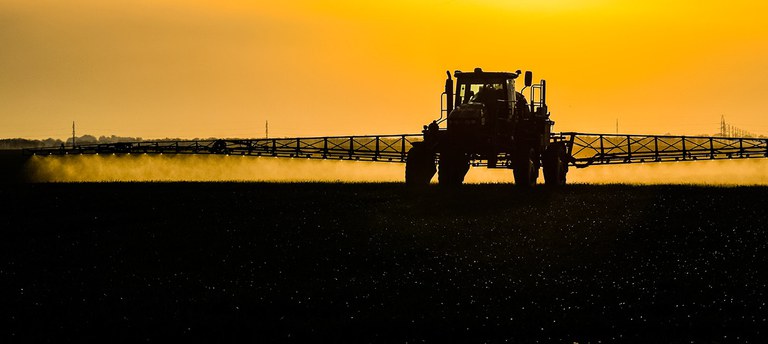Effectiveness of Using Low Rates of Plant Nutrients (SF1978, Revised August 2020)
Availability: Web only
“Low rates” refers to supplemental crop nutrients added at rates much less than crop removal or much less than rates recommended by land-grant university soil fertility specialists. Low rates of crop nutrients sometimes are applied through the use of fertilizers with a low nutrient analysis (1-1-1) or by application of low rates of higher analysis fertilizers (9-18-9).
Also, nontraditional products may promote low total plant mineral nutrient rates through the application of low-analysis products or low rates of higher-analysis products, with or without alternative additives to replace or enhance fertilizer nutrients. In each case, producers should give careful consideration to the potential for optimal crop response (yield or other desired outcome) that is based on university research conducted in similar soils or geographic regions.
Some farmers may choose to use low rates of fertilizer to reduce input costs. When soil test levels of nutrients are high and very high, nutrient additions are generally not recommended or are recommended at lower than crop removal rates. However, if soil test levels are very low or low, rates more than crop removal often are recommended, particularly for broadcast fertilizer application.
Decisions on rate reductions need to be considered in relation to potential yield response and method of application that may enhance response, compared with traditional broadcasting. Foliar fertilizer or fertilizer applied with the seed generally also are applied at low rates due to constraints related to plant tissue “burn” and seed germination/seedling safety. Although low rates of nutrients may be appropriate to apply at certain times, careful consideration should be made of all factors that may influence short-term and long-term crop yield, maintenance of soil tests and potential environmental impacts.
Fourteen essential mineral nutrients are required for growth and forage/grain yield of most crops. The approximate mineral content, with the exception of nickel (Ni), of crop components commonly grown in the North Central Region are listed in Table 1. Clearly crop harvest can remove considerable nutrients from fields. However, not all nutrients should or need to be replaced.
The reason for fertilization is for the farmer to be profitable in the current season and to position the soil for continued profitability into the future. This is important because many nutrients are supplied at adequate levels naturally from the soil and are removed at such low rates that fertilization isn’t needed.
Several examples are micronutrients or nutrients, particularly calcium (Ca) and (Mg), which are replaced with liming low-pH soils. In other cases, nutrient removal is so large that fertilization is required in the long term to maintain the soil nutrient resource.
Prime examples are phosphorus (P) and potassium (K). For some nutrients, the soil supply of the crop-available form is so low that deficiency always occurs and needs fertilization for optimal supply, typically a specific crop-nutrient interaction with certain micronutrients.
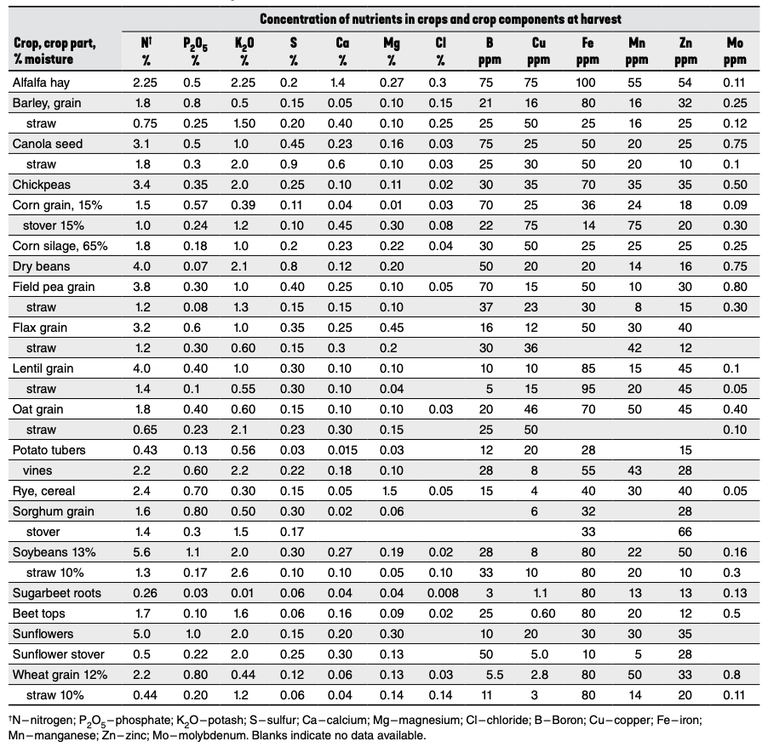
- Table 1. Approximate concentrations of mineral elements in crops grown in the North Central Region at harvest. Considerable variation occurs in a crop in elemental concentration.
Use of Low Rates of Plant Nutrients as In-furrow or Near-furrow Starter Fertilizers at Planting
Corn
Generally, the positive response of phosphorus (P)- based starter fertilizer in North Central Region research is least in the south and increases the further north that the trials were conducted. For example, the average corn yield increase in southern Illinois was from 5 to 10 bushels/acre (bu/a) in about 25% of studies. In central Illinois, the yield increase tended to range from 10 to 15 bu/a about 50% of the time, and in northern Illinois, the yield increase tended to be about 20 bu/a about 75% of the time (Ritchie et al., 1993).
Wisconsin starter P research on 11 sites showed an average of 4 bu/a corn yield increase with starter P, with similar results in seed-placed treatments, compared with 2 inches to the side and 2 inches below the side treatments (2X2). The research showed a tendency for central Wisconsin sites to be more responsive, compared with southern Wisconsin sites (Lauer, 2019).
In Indiana (Camberato et al., 2016), a 2X2 starter P study with six sites having optimum P soil test values (27 to 34 parts per million [ppm] Bray P1) from northern Indiana to southern Indiana showed yield increases at one northern site due to pop-up starter P. Additional yield increase was experienced at this site and one southern site with application of ammonium polyphosphate and 50 pounds of nitrogen (N)/acre in a 2X2 inch band at planting. Both responsive sites were under no-till production.
In a series of P and sulfur (S) starter experiments from four southern Minnesota sites, one in four sites had a yield increase from P starter (Kim et al., 2013). In Minnesota experiments on no-till corn, seed-placed starter P was effective in increasing yields, with the greatest benefit on continuous corn and in a planting system without row cleaners and planting directly into residue (Vetsch and Randall, 2000).
In Iowa, a summary of 31 field trials of broadcast P (100 to 150 pounds/acre P2O5), compared with 5 to 25 pounds of P2O5 per acre as a seed-placed or 2X2 placed starter P alone and starter P plus broadcast P found corn yield increases of about 7% with starter alone, yield increases of about 14% from broadcast P alone and about 15% from broadcast plus starter P on sites where the soil test P was less than 16 ppm Bray P1 (low soil test category) (Mallarino, 2009). At the optimal soil test range (16 to 20 ppm Bray P1), the corn yield increase from starter alone was 7%, while the yield increase from broadcast or broadcast plus starter P was about 8%.
At sites in the high soil test range (21 to 30 ppm Bray P1), the corn yield increases from starter alone and broadcast plus starter P was about 5%, while the corn yield increase from broadcast alone was about 6%. For sites greater than 30 ppm Bray P1, the corn yield increase was about 1% from starter alone, 2% for broadcast alone and 4% for broadcast plus starter P. An additional Iowa study on eight no-till sites showed that yield increase when soil test P was adequate was more likely due to the additional N applied near the seed at planting than from the P component of the starter fertilizer.
Although the economics of broadcast rates of P compared with starter rates of P may play a financial role in a grower decision to reduce or eliminate broadcast P in hard economic times when the soil test P is in the high soil test range, P removal by the crop eventually will result in a reduction of soil test P values and a decrease in future yield potential. However, Illinois research on two fields subjected to a long period of buildup P fertilizer application followed by no P application showed that the decrease in soil test P was less than what would be predicted by the buildup P rate vs. soil test P change relationship (Franzen, 1993).
Therefore, a starter P application used occasionally instead of a greater rate of broadcast P would not be expected to reduce soil test P a great deal, and expected yield in the year of starter-only application would probably be similar to that which would have been achieved using a broadcast P rate four to six times as great if the soil test P was optimum or greater.
A Kansas study evaluated starter P fertilizer applied as 2x2 band and 2x0 surface band on corn, either alone or in combination with higher rates of broadcast or deep-band with the strip-till. Results during a period of 10 years showed increased yields with starter fertilizers, with greater yield increase in high-yield environments with greater P crop removal through time. Starter fertilizers applied in combination with broadcast or deep-band were superior to broadcast or deep-band P alone (Preston et al).
In North Dakota, at the most northern of starter P trials for corn recorded in the North Central Region near Carrington, N.D., the greatest response to starter P in the region was recorded. Yield increases over the check due to 6 to 8 gallons/acre of 10-34-0 in-furrow were about 50 bu/a (Hendrickson, 2007) in soil with low soil test P.
Overall, starter P application for corn is more likely to increase yield in northern geographies and in soils with lower soil test P. In states where a low likelihood of crop failure is present (the central U.S. Corn Belt or under irrigation), and research supports a maintenance fertilization strategy, starter P use is recommended less, and greater broadcast P rates usually result in greater yield.
The use of starter P rates alone result in reduced soil test P values, which limit yield potential. In northern states, particularly North Dakota, starter P application always is advised for corn, and economic returns would be realized in all but the warmest of spring planting seasons.
Starter potassium (K) application also has been explored in the region, particularly in Iowa. In general, starter K application can increase yield in low-testing soils, but greater rates of broadcast K usually are recommended so that the soil tests will build to optimal values. In no-till studies, deep-banded K has been superior to starter K in increasing yield (Mallarino).
Soybeans
Soybeans usually are not responsive to low rates of plant nutrients at seeding. Studies in North Dakota show that seed-placed fertilizer can reduce yield substantially. Low-salt fertilizers have similar safety restrictions as 10-34-0 based fertilizers due to the N in low-salt formulations consisting of either UAN (urea, ammonium nitrate solutions) or urea additions for their N component.
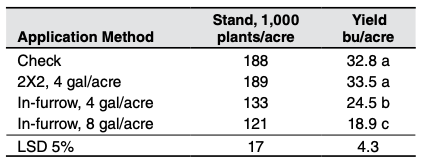
- Table 2. Soybean yield with starter fertilizer application,Carrington, N.D., 2008. Means of treatments using 10-34-0based and low-salt starter fertilizers. (Endres and Hendrickson, 2008)
Wheat
Spring Wheat
Many trials using a low rate of starter P in spring wheat have been conducted during the past several decades. Rates of P applied as a seed-placed starter fertilizer usually range from 20 to 40 pounds of P2O5/acre. In one of the more recent trials (Goos and Johnson, 2001), the application of 26 pounds of P2O5/acre with the seed at planting resulted in an average 15% yield increase over the untreated check at eight sites, ranging in soil test P values from low to high categories.
A study in northwestern Minnesota across three years investigated starter P compared with broadcast P at the same rate. The results showed that wheat yields were similar whether the P was broadcast or banded. This is in contrast to previous work in Manitoba.
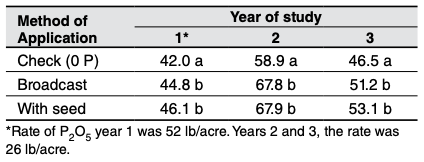
- Table 3. Comparison of spring wheat yield with P broadcastand applied with the seed. (from Rehm et al., 2003)
The use of P on spring wheat is an economic decision in the northern Plains of the North Central Region. The cost of P fertilizer and price of wheat may enter into decisions on what rate of P to apply.
Halvorson developed a relationship between spring wheat yield and P rate and used it to produce an economic analysis to help growers determine the profitability of the use of greater than minimal rates of P as a starter. The greater the P cost, the lower the soil test value needed to support higher yields to offset the costs (Figure 1).
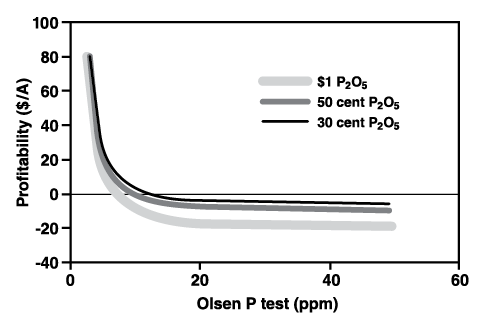
- Figure 1. Profitability of application of more than minimal P as a starter with cost of P and a spring wheat price of $6/bushel. (From Halvorson, 1986)
Winter Wheat
In contrast to spring wheat, yield increase from P fertilizer tends to be similar in winter wheat whether the application was broadcast at seeding or banded when the P soil test is at least in the medium range (Halvorson et al., 1992; Karamanos et al., 2003). When the P soil test is low, banded P with ammonium-N, similar to that applied when the P source is MAP (11-52-0) or DAP (18-46-0), or a liquid starter such as 10-34-0, was superior to a broadcast P application the same rate in Kansas (IPNI, 1999).
Whether the P fertilizer was banded or broadcast, in most studies, the rate of similar P responses was the same regardless of placement, so low rates of seed-banded or near-seed-banded P were not more effective at increasing yield as the recommended rates of band or broadcast P. However, in late planted wheat, banded P consistently shows a good yield response even when the soil test P is optimum due to limited fall tillering with a late planting date.
Use of Low Rates of Starter Fertilizer at Seeding in Other Crops in the North Central Region
Sugarbeets
Historically, P was applied to sugarbeets at relatively high rates, compared with other crops in the North Dakota/Minnesota region. Broadcast P rates of more than 100 pounds of P2O5 per acre were common, given that most soil tests for P in the region were in the low to medium categories. However, studies in northwestern Minnesota found that a 3 galllons/acre rate of 10-34-0 with the seed at planting resulted in similar root and sugar yield, compared with a much larger rate of broadcast P (Figure 2) (Sims and Smith, 2003).
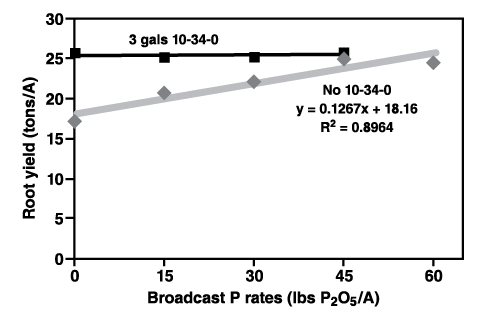
- Figure 2. Sugarbeet root yield with 3 galllons/acre 10-34-0,compared with broadcast P rates. (Sims and Smith, 2003)
Canola
Canola is very responsive to near-seed-placed P fertilizer and seed-placed P fertilizer, provided that seed-placed rates do not exceed rates that reduce stand. In a Manitoba study (Bailey and Grant, 1990), a starter P rate of 28 pounds/acre of P2O5 produced as great a canola yield increase as broadcasting 69 pounds/acre of P2O5.
Value of Foliar Fertilizer Application on Crops in the North Central Region
In spring wheat, when protein premiums from buyers are expected to be high, some growers apply an early post-anthesis application of UAN or liquid urea fertilizer broadcast at a rate of 30 pounds of N/acre. Some slow-release N products have entered this market with claims of much greater N efficiency compared with UAN or urea.
Experiments in North Dakota found that these products were no more efficient at increasing protein than UAN or urea (Franzen, 2019). If used at the same rate of N as UAN or urea, their effect was equivalent, but reduced rates resulted in reduced effects.
In soybeans, several experiments have researched foliar fertilizer application mid to late season. In Iowa, application of foliar fertilizer to soybeans at 27 sites having optimum or greater levels of soil test P and K at V5 resulted in two small yield increases and four small yield decreases not related to leaf burning (Haq and Mallarino, 2000).
Further study on 18 sites, with treatments including S, Fe, B and Zn, resulted in a similarly low positive response rate (Mallarino et al., 2001). A review of foliar fertilization (Fageria et al., 2009) states that foliar fertilization usually affects plants temporarily, while soil-applied fertilization supplies the plant the entire season. They also observe that foliar fertilization might be best used to supply micronutrients when a soil application may not be effective.
An analysis was made of 207 environments that evaluated N application to soybeans in the U.S. (Mourtzinis, 2018). Environment had a much larger effect on soybean yield than N rate or timing.
Overall, a single N application yielded about 0.9 bu/a more than the 0 N check, while a split N application yielded about 1.8 bu/a more than the check. Yield increases due to N application for soybeans were generally small and would have been difficult to justify economically.
Conclusions
Fertilizer rates recommended and published by Extension soil fertility and plant nutrition specialists in the North Central Region are the product of many, sometimes hundreds, of fertilizer rate studies in each state. In specific crops and in specific circumstances, short-term profitability improvement might be possible by applying fertilizer rates less than that recommended.
Crops that respond very profitably to low rates of P fertilizers in a seed-placed or near-seed-placed band at planting are sugarbeets, canola, spring wheat and barley. Corn is very responsive in some years to low rates of P fertilizer with or near the seed at planting, particularly in North Dakota and more northern states in the North Central Region. In other states, the response of corn to lower P fertilizer rates is less in frequency and magnitude.
Although low rates of banded fertilizers may improve crop profitability in the short term in some circumstances, continued use of lower rates of fertilizer compared with crop removal will decrease the amount of available nutrients to crops and may result in chronic yield decreases that affect future production and long-term profitability.
Using low rates of fertilizer to try to achieve greater nutrient use efficiency has not been effective in consistently increasing yields, crop quality and profitability in the region. Foliar fertilization of macronutrients in the North Central Region is not an effective or efficient application method to supply these nutrients to our crops.
References
Bailey, L.D. and C.A. Grant 1990. Fert placement studies on calcareous and non-calcareous chernozemic soils: Growth, P uptake, oil content and yield of Canadian rape. Comm Soil Sci and Plant Anal. 21:2089-2104.
Bender, R.R., J.W. Haegele and F.E. Below. 2015. Nutrient uptake, partitioning, and remobilization in modern soybean varieties. Agronomy Journal 107:563-573.
Biel, W., A. Jaroszewska, D. Gaweda and G. Hury. 2018. Content of minerals in soybean seeds as influenced by farming system, variety and row spacing. Journal of Elementology 23(3):863-873. Doi:10.5601/jelem.2017.22.3.1483.
Bravo, S., G.S. Lee and W.R. Schmehl. 1989. The effect of planting date, nitrogen fertilizer rate and harvest date on seasonal concentration and total content of six macronutrients in sugarbeet. Journal of Sugar Beet Research 26(1):34-49.
Camberato, J., C. Hornaday and R. Nielsen. 2016. Response of corn to starter fertilizer-research update. www.soilfertility.info/news/starterfertilizer.pdf” www.soilfertility.info/news/starterfertilizer.pdf.
Card, S., J. Cathcart and J. Huang. 2005. The micronutrient and trace element status of crops grown on the Alberta soil quality benchmark sites. AESA Soil Quality Monitoring Program Alberta Agriculture, Food and Rural Development Conservation and Development Branch. Edmonton, Alberta, Canada.
Endres, G., and P. Hendrickson. 2008. Soybean response to in-furrow fertilization. Carrington Research Extension Center Annual Report. www.ag.ndsu.edu/carringtonrec/documents/agronomyrd/docs2011/2011%20Soybean%20Response%20to%20In-furrow%20Fertilizer.pdf.
Fageria, N.K., M.P. Barbosa Filho, A. Moreira and C.M. Guimarães. 2009. Foliar fertilization of crop plants. Journal of Plant Nutrition 32:6, 1044-1064. doi:10.1080/01904160902872826.
Franzen, D.W. 1993. Spatial variability of plant nutrients in two Illinois fields. PhD Thesis. pp. 40-48. University of Illinois, Urbana, Ill. www.ideals.illinois.edu/handle/2142/72615
Franzen, D., A. Robinson and C. Rosen. 2018. Fertilizing potato in North Dakota. NDSU Extension publication SF715 (revised). www.ag.ndsu.edu/publications/crops/fertilizing-potato-in-north-dakota/sf715.pdf.
Franzen, D. 2019. White paper on use of slow-release N fertilizers. www.ndsu.edu/fileadmin/snrs/2020_Website_Revamp/foliarNreport.pdf
Goos, R.J. and B.E. Johnson. 2001. Response of spring wheat to phosphorus and sulphur starter fertilizers of differing acidification potential. Journal of Agricultural Science 136:283-289.
Halvorson, A.D. 1986. Phosphorus management for MEWY and quality. 12 p. Presented at Hands-On Workshop for Implementing Maximum Economic Wheat Yield Systems. July 8-11, 1986. Bismarck, N.D.
Halvorson, A.D. 1992. No-till winter wheat response to phosphorus placement and rate. Soil Science Society of America Journal 56:1635-1639.
Haq, M.U., and A.P. Mallarino. 2000. Soybean yield and nutrient composition as affected by early season foliar fertilization. Agronomy Journal 92:16-24.
Hendrickson, P. 2007. Corn response to fertilizer placement and starter fertilizer rates, NDSU Carrington Research Extension Center. www.ag.ndsu.edu/archive/carringt/agronomy/Research/Fertility/07%20Corn%20Response%20to%20Starter%20Fertilizer.pdf
Hopkins, B.G., and N.C. Hansen. 2019. Phosphorus management in high yield systems. Journal of Environmental Quality. 48:1265-1280. doi:10.2134/jeq2019.03.0130 IPNI. 1999. Phosphorus fertilizer placement. Better Crops with Plant Food/Volume 83 No.1, pp 34-39.
Karamanos, R.E., T.A. Stonehouse and N.A. Flore. 2003. Response of winter wheat to nitrogen and phosphate fertilizer placement and time of application. Canadian Journal of Plant Science 83:484-488.
Kim, K-I, D.E. Kaiser and J. Lamb. 2013. Corn response to starter fertilizer and broadcast sulfur evaluated using strip trials. Agronomy Journal 105:401-411. doi:10.2134/agronj2012.0299
Latshaw, W.L. 1924. Elemental composition of the corn plant. Kansas Agricultural Experiment Station. Paper No. 219. Manhattan, Kan. In Journal of Agricultural Research. Vol. 27, 11:845-860.
Lauer, J. 2019. Corn response to banded fertilizers at planting. Wisconsin corn blogspot, March 20, 2019. http://wisccorn.blogspot.com/2019/03/B09920.html
Mallarino, A.P. 2009. Phosphorus and potassium placement methods for corn and soybean: An Iowa perspective. pp. 109-115. In Proceedings of the 2009 Wisconsin Crop Management Conference, Vol. 48. University of Wisconsin, Madison, Wis.
Mallarino, A.P., M.U. Haq, D. Wittry and M. Bermudez. 2001. Variation in soybean response to early season foliar fertilization among and within fields. Agronomy Journal 93:1220-1226. doi:10.2134/agronj2001.1220
Mallarino, A.P., D.E. Kaiser, D.A. Ruiz-Diaz, C.A.M. Laboski, J.J. Camberato and T.J. Vyn. 2017. Micronutrients for soybean production in the North Central Region. Iowa State University Extension and Outreach CROP 3135 (Revised) September 2017. Ames, Iowa.
Mathers, A.C., and B.A. Stewart. 1982. Sunflower nutrient uptake, growth, and yield as affected by population. Agronomy Journal 74:911-915.
Moraes, M., and E. Ferreira. 2012. Biofortification of trace elements in food crops for human health. Communications in Soil Science and Plant Analysis 43:556-570. doi:10.1080/00103624.2012.639431
Mourtzinis, S., G. Kaur, J.M. Orlowski, C.A. Shapiro, C.D. Lee, C. Wortmann, D. Holshouser, E.D. Nafziger, H. Kandel, J. Niekamp, W.J. Ross, J. Lofton, J. Vonk., K.L. Roozeboom, K.D. Thelen, L.E. Lindsey, M. Staton, S.L. Naeve, S.N. Casteel, W.J. Wiebold and S.P. Conley. 2018. Soybean response to nitrogen application across the United States: A synthesis-analysis. Field Crops Research 215:74-82. dx.doi.org/10.1016/j.fcr.2017.09.035
Preston, C.L., D.A. Ruiz Diaz and D.B. Mengel. 2019. Corn Response to Long-Term Phosphorus Fertilizer Application Rate and Placement with Strip-Tillage. Agron. J. 111:1–10 doi:10.2134/agronj2017.07.0422
Rehm, G.W., A.L. Sims and J.A. Lamb. 2003. Influence of rate and placement of phosphate fertilizer on growth and yield of hard red spring wheat in diverse tillage systems. Nutrient Cycling in Agroecosystems 67:75-83.
Ritchie, K.B., R.G. Hoeft, E.D. Nafziger, L.C. Gonzini and J.J. Warren. 1996. Starter fertilizers for minimum-till corn. Proceedings of the Illinois Fertilizer and Chemical Association Conference, 1996. pp. 15-25.
Shtangeeva, I., S. Lierhagen and E. Steinnes. 2011. Macronutrients and trace elements in rye and wheat: Similarities and differences in uptake and relationships. Environmental and Experimental Botany 70:259-265. doi:10.1016/j.envexpbot.2010.09.013
Sims, A.L., and L.J. Smith. 2003. Use of banded in-furrow phosphorus to reduce broadcast applications in sugarbeet production. In 2003 Sugarbeet Research and Extension Reports. Vol. 34. pp. 129-138.
Vetsch, J.A., and G.W. Randall. 2000. Enhancing no-tillage systems for corn with starter fertilizers, row cleaners and nitrogen placement methods. Agronomy Journal 92:309-315.
For more information on this and other topics, see www.ndsu.edu/extension


